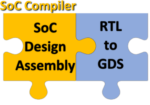At the recent TSMC Technology Symposium, TSMC provided a detailed discussion of their development roadmaps. Previous articles have reviewed the highlights of silicon process and packaging technologies. The automotive platform received considerable emphasis at the Symposium – this article specifically focuses on the… Read More
Highlights of the TSMC Technology Symposium 2021 – Packaging
The recent TSMC Technology Symposium provided several announcements relative to their advanced packaging offerings.
General
3DFabricTM
Last year, TSMC merged their 2.5D and 3D package offerings into a single, encompassing brand – 3DFabric.
2.5D package technology – CoWoS
The 2.5D packaging options are divided into the CoWoS… Read More
Highlights of the TSMC Technology Symposium 2021 – Silicon Technology
Recently, TSMC held their annual Technology Symposium, providing an update on the silicon process technology and packaging roadmap. This article will review the highlights of the silicon process developments and future release plans.
Subsequent articles will describe the packaging offerings and delve into technology … Read More
WEBINAR: 5 Reasons Why a High Performance Reconfigurable SmartNIC Demands a 2D NoC
If you are involved in designing systems that process data, you’re going to want to attend this webinar. Practically speaking, this should include a large percentage of the SemiWiki readership. Since data is the new oil there are a lot of applications drawn to data and information processing. Before we explore this webinar, let’s… Read More
Silicon Catalyst is Bringing Its Unique Startup Platform to the UK
Silicon Catalyst is a unique startup incubator / accelerator that focuses exclusively on accelerating solutions in silicon (including chips, IP, MEMS & sensors). The organization has an extensive support infrastructure that includes preferred access to IP, design tools, business infrastructure and fab/assembly. … Read More
Analog Sensing Now Essential for Boosting SOC Performance
In today’s System-on-Chip (SOC), analog blocks are used in many places such as I/O cells for communication, PLLs for generating clocks, LDO’s for converting supply voltage to internal rail voltage, Sensors for qualifying external characteristics such as temperature, light, motion, etc. However new advanced designs now require… Read More
TSMC 2021 Technical Symposium Actions Speak Louder Than Words
The TSMC Symposium kicked of today. I will share my general thoughts while Tom Dillinger will do deep dives on the technology side. The event started with a keynote by TSMC CEO CC Wei followed by technology presentations by the TSMC executive staff.
C.C. Wei introduced a new sound bite this year that really resonated with me and that… Read More
Upcoming Webinar: PUFiot, A NeoPUF-based Secure Co-Processor
Throughout history, people have sought after security as a basic right and expectation within a civilized society. Even as recent as a few centuries ago, things were very simple. Subjects looked to their rulers to provide security for their lives and assets. Assets were mostly hard assets such as jewelry, coins or real estate. … Read More
Machine Learning Applied to Increase Fab Yield
Machine learning applications have become pervasive and increasingly complex, from recommendation agents in online interactions to personal assistants for command response to (ultimately) autonomous vehicle control. Yet, an often overlooked facet of machine learning technology is the deployment in industrial process… Read More
WEBINAR: What Makes SoC Compiler The Shortest Path from SoC Design Specification to Logic Synthesis?
Defacto SoC Compiler whose 9.0 release was announced recently automates the SoC design creation from the first project specifications. It covers register handling, IP and connectivity insertion at RTL, UPF and SDC file generation right to logic synthesis. As part of the generation process of RTL and design collaterals, basic… Read More











Quantum Computing Technologies and Challenges